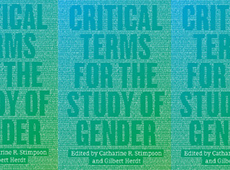Critical Terms for the Study of Gender
Edited by Catharine R. Stimpson and Gilbert Herdt
Chapter 13, Nature
Anne Fausto-Sterling
Abstract

My dreams sometimes conjure up the woods and stream visible from the living room window of my childhood home. The images are vivid, in color and gender-specific. The pheasant I watch is not merely a bird but, with ornithological precision, a brilliantly colored male with long, magnificent tail feathers, or a brown, well-camouflaged, short-tailed female; the ducks are either mottled brown mallard mothers with ducklings in tow, or the bright green-headed male. The state of nature in my reverie is serene and safe. When danger enters, it is always human or monstrous, a thing capable of destroying my natural haven. In my childhood, danger did, indeed, come from without, from humans who did not care for Communists or Jews, or smart, intellectual, independent adolescent girls. Safety and solace lay in the woods. Those youthful sensations of safety and danger still lie so strongly within me that I can barely suppress my alarm when interacting with students who may never have seen a live frog or even a living cow, and who find natural objects such as worms and snakes neither comforting nor awe-inspiring but repellant. Clearly, my relation to and understanding of that thing we call nature differs from those of my students. Indeed, over the centuries humans have devised varied accounts of the natural world and their relation to it. But there is nothing natural about nature. The pheasants that wandered through my family’s woodland symbolized my safe haven, but the bird did not arrive on US shores until 1866 (Palmer 1899), imported by bird lovers anxious to establish Eurasian species on American soil.
Click here to view and download the entire chapter.
